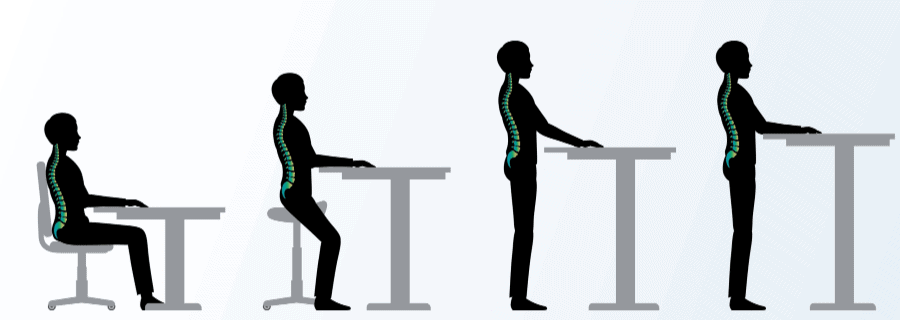“Your job is a place you work for money. Your vocation is a calling you simply must fulfill. It is your purpose and gives you a reason to wake up.”
For many people working and returning to work is not only something they must do because they need to pay their bills, but it is something they need to do because it’s what gets them out of bed in the morning. After an injury, illness, or medical event, there may be many barriers you face to accomplish this. Occupational therapy can help you continue working or help you return to work with the right therapy.
Is your ability to work and remain at work being impacted?
Many people come to see us when working and returning to work becomes difficult or is not an option because of an injury, declining stage of a progressive illness, joint replacement surgery, generalized weakness, balance and dizziness, or their memory/brain/thinking has been disrupted in some way.
Along with vocational rehabilitation, outpatient occupational therapy can address upper body and lower body physical concerns, and psycho-social barriers that may be preventing you from working or returning to work.
Click here for problems you may face while currently working
If you are still working, you may face many problems that are keeping you at your best.
- Poor seating and positioning causing lower back pain or pins and needles in your feet.
- Poor positioning of equipment and/or technology causing you to ‘hunch’ resulting in neck problems and chronic pain
- Perpetually using a keyboard, mouse, and other equipment not maximized for proper ergonomics
- Standing for long periods of time without the proper foot support and protection
- Being exposed to loud noises without proper ear protection
- Poor lighting or lack of blue light control causing headaches, dizziness, or other visual perceptual problems
- Lack of rest breaks causing muscle fatigue, exhaustion, and judgment errors
- The demands of the job are becoming more difficult due to delayed information processing, decreased focus and attention, increased confusion, or a decreased ability to multi-task
Many people are unable to return to work because of a recent physical change
- Joint replacement procedure
- Bone fracture, muscle tear, or other orthopedic trauma
- Chronic Pain
- Progressive Neurological Disease
- Decreased balance and mobility
- Traumatic medical event affecting the whole person: traumatic brain injury, stroke, car accident, amputation, new diagnosis
- Memory impairments
- Joint instability
- Lower back pain
- Chronic headaches
- and more!
Whether you have not worked for a while due to an injury or you are an older adult re-entering the workspace, you may benefit from outpatient occupational therapy and vocational support
- Identify skills and strengths
- Create a list of jobs that may be suitable for your desires
- Practice interview skills and working skills
- Create an action plan with goals and mile markers
- Discuss and prepare for boundaries, obstacles, and hurdles
- Establish the mode of transportation to bring you to interview/work
- Ensure you are able to perform job duties and roles
Other Specialized
Areas of Practice
Upper Body and Lower Body Rehabilitation
In order to be functional experts, occupational therapists are fully trained in human anatomy- both upper body and lower body rehabilitation strategies and techniques. This allows us to address upper body and lower body diagnoses, posture, balance deficits, and more. We use various treatment methods such as exercises, stretching, training in body mechanics, massage and manipulation, endurance and stamina activities, stair climbing, walking training, and modalities such as e-stim, vibration, cold, and heat.
Vocational Rehabilitation
Vocational Rehabilitation helps you get back to doing what you love and find meaningful. If you have recently experienced a traumatic medical event, been given a diagnoses affecting your livelihood, or have a loved one needing support and training to enter the work-field for the first time, Buffalo Occupational Therapy can provide vocational rehabilitation for a reasonable cost.
Geriatric Rehabilitation
Current research has revealed the human body goes through enough changes over the age 65 to demand a unique approach to medicine and rehabilitation. Buffalo Occupational Therapy uses a Neuro Therapeutic approach partnered with their knowledge of human development to treat older adults through Geriatric Rehabilitation.
Neurological Rehabilitation
Neurological Rehabilitation uses a variety of techniques and methods to promote neuroplasticity, neuronal re-patterning, and return of function to enhance daily living. It is used to help those who have been diagnosed with Neuro-related illness, like Alzheimer's, dementia, Parkinson's, or Multiple Sclerosis, suffered a stroke, brain injury, or spinal cord injury.
Kinesiology Taping
Buffalo Occupational Therapy is specialized in applying kinesiology taping techniques to the skin in order to enhance neural plasticity, support recovery, offer joint support, reduce chronic pain, decrease nerve pain, and help correct muscle imbalances.
Adaptive and Durable Medical Equipment
Buffalo Occupational Therapy offers specialized advice on appropriate adaptive equipment and durable medical equipment for aging in place as well as maximizing independence when living with a progressive disease or chronic illness. Offering low-cost options to address your concerns is something we pride ourselves on, and if we can't offer you a solution, we will find someone who can!
Functional Rehabilitation
Your content goes here. Edit or remove this text inline or in the module Content settings. You can also style every aspect of this content in the module Design settings and even apply custom CSS to this text in the module Advanced settings.
Environment and Home Assessments
Ensuring your personal physical environment and home environment is accessible and safe is just one area of occupational therapy practice. Buffalo Occupational Therapy is specialized in assessing your physical symptoms and needs and applying this information to creating a livable environment both now and throughout the course of your diagnosis. Occupational therapists seek to maximize independence to keep you living in the place of your choice.
Cognitive Therapy and Dual Tasking
Buffalo Occupational Therapy has a special focus in neuroanatomy and what each area of the brain controls in terms of information processing, functional performance, and executing gross mobility. Where many other practices only work on mobility or only work on cognition, Buffalo OT is the only practice in Western New York, addressing both needs in one plan of care. Dual tasking and cognitive therapy is an area BOT feels very confident in addressing as we have seen amazing therapy outcomes.
Your rehab specialist will offer you many
Are you facing a specific diagnosis or condition effecting your functional performance?
Check out some examples of conditions we treat through outpatient rehabilitation!
Why choose Buffalo Occupational Therapy?
Buffalo Occupational Therapy works with you one-on-one to create a treatment plan that will meet your needs, accomplish your desired outcomes, and restore your hope in recovery.
Buffalo Occupational Therapy practitioners are committed to maintaining current competencies, meeting monthly continuing education goals, and being well-versed in the latest evidence-based, research-driven treatment models in order to offer you the best treatment possible.
Specialized occupational therapy practitioners are accessible to their patients, invested in producing treatment plans that will produce results, maximize time spent, and offer you hope for recovery.
Buffalo Occupational Therapy is currently the first and only Neuro-centered adult outpatient occupational therapy practice specializing in neurological rehabilitation, functional performance, and rehabilitation for older adults.
Helpful Page Definititions
Muscle Imbalance
Your body is complex and should be working synergistically with all of its parts. When some muscles have become weaker while others remain strong, an imbalance occurs which causes decrease balance, standing tolerance, and joint stability.
Activities of Daily Living
Occupational therapists are trained in occupations and activity analysis. An occupation is an activity that you believe is important to your life. There are many levels of occupations, but activities of daily living (ADLs) are the most personal activities and are usually the ones people find most important if they were to lose the ability to complete them.
ADLs include:
- Bathing and showering
- Getting dressed
- Going to the bathroom
- Walking and getting up and down from a chair or car
- Eating and swallowing
- Feeding
- Sexual activity
- Personal hygiene and grooming
- Being able to use personal care devices like adaptive equipment and durable medical equipment
Visual Perception
We incorporate visual perceptual elements into many treatments to enhance perception, balance, safety, cognition, memory, recall and neural excitation. Some areas of visual perception include form constancy, visual discrimination, figure-ground perception, visual closure, visual memory, and visual sequential memory.
Mobility Aid
As occupational therapists, we can assess functional movement and recommend adaptive equipment as well as durable medical equipment that will enhance your community mobility. Before we can make any recommendations, we must assess your ability to move and determine how you are walking and holding your posture, if you are presenting with muscle imbalances, the status of your upper body and lower body range of motion and flexibility deficits and finally, determine the status of your muscle stamina. After we complete this assessment, we can help you decide what mobility aid would be most appropriate for you, if any.
Types of mobility aids include cane (single point, quad cane, tripod cane), crutches, knee scooter, cane-crutch combination, walkers (4 wheeled walker, 2 wheeled walker, standard walker), walker-cane hybrid, hemi-walker, gait trainer, scooters, wheelchairs and more.
We will help decide what device would be most appropriate, help with positioning, and then train you on best practices to maximize your mobility!
Neuromuscular Re-education
NMRE is used by neurocentric occupational therapists to improve communication between your muscular system and nervous system. By promoting this stream of communication, you close the circle of recovery. Without NMRE, you can have the biggest muscles in the world and still experience mobility deficits due to poor reaction time, coordination, and mixed signals.
Comprehensive Evaluation
Occupational therapists treat the entire person. Much like your primary care physician, we were required to learn elements of the entire body so that we could treat holistically (a one stop shop). Because of this, your outpatient rehabilitation specialist will perform an evaluation that assesses the following things:
- Personal history
- Who are you? What do you do? What makes you tick? Why are you seeking outpatient therapy?
- Physical function (upper body and lower body)
- Strength, range of motion, and flexibility
- Neuromuscular function (brain to muscle communication)
- Coordination, speed, agility, and reaction time
- Cognitive and Mind health
- Short term memory, recall, information processing, and perception of illness
- Occupational Inventory (Activity and role inventory)
- Roles you play like a caregiver, spouse, parent, employee, etc.
- Mobility inventory like the places you need to go
- IADL inventory and what activities are required for you to be independent
- Other activities that are important to you


